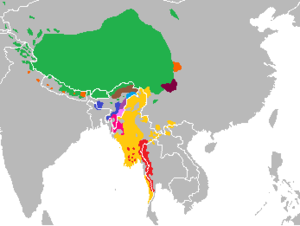
Back Tibeto-Birmaanse tale Afrikaans لغات تبتية بورمية Arabic Llingües tibetano-birmanes AST Tibet-Birma dilləri Azerbaijani Тыбета-бірманскія мовы Byelorussian Тибето-бирмански езици Bulgarian བོད་འབར་སྐད་རིགས། Tibetan Yezhoù tibetek-burmek Breton Llengües tibetobirmanes Catalan Tibetobarmské jazyky Czech
| Tibeto-Burman | |
|---|---|
| Geographic distribution | Southeast Asia, East Asia, South Asia |
| Linguistic classification | Sino-Tibetan
|
| Proto-language | Proto-Tibeto-Burman |
| Subdivisions |
|
| Language codes | |
| ISO 639-5 | tbq |
| Glottolog | None |
 | |
The Tibeto-Burman languages are the non-Sinitic members of the Sino-Tibetan language family, over 400 of which are spoken throughout the Southeast Asian Massif ("Zomia") as well as parts of East Asia and South Asia. Around 60 million people speak Tibeto-Burman languages.[1] The name derives from the most widely spoken of these languages, Burmese and the Tibetic languages, which also have extensive literary traditions, dating from the 12th and 7th centuries respectively. Most of the other languages are spoken by much smaller communities, and many of them have not been described in detail.
Though the division of Sino-Tibetan into Sinitic and Tibeto-Burman branches (e.g. Benedict, Matisoff) is widely used, some historical linguists criticize this classification, as the non-Sinitic Sino-Tibetan languages lack any shared innovations in phonology or morphology[2] to show that they comprise a clade of the phylogenetic tree.[3][4][5]
- ^ Eberhard, David M.; Simons, Gary F.; Fennig, Charles D., eds. (2019). Ethnologue: Languages of the World (22nd ed.). Dallas, Texas: SIL International.
- ^ Guillaume, Jacques (2012). "The Tangut Kinship System in Qiangic Perspective". In Hill, Nathan (ed.). Medieval Tibeto-Burman Languages IV. p. 215.
- ^ Handel (2008), p. 431.
- ^ Guillaume, Jacques (2007). "A shared suppletive pattern in the pronominal systems of Chang Naga and Southern Qiang". Cahiers de Linguistique Asie Orientale. 36 (1): 2.
- ^ DeLancey, Scott (2013). "The origins of Sinitic". In Zhuo, Jing-Schmidt (ed.). Increased Empiricism: Recent advances in Chinese Linguistics. John Benjamins. p. 74.